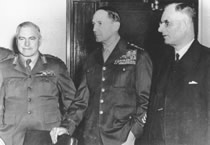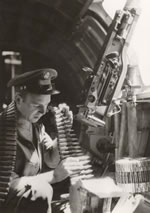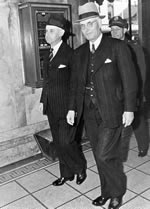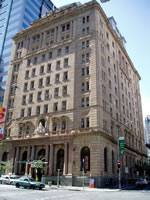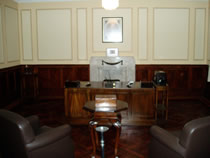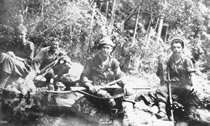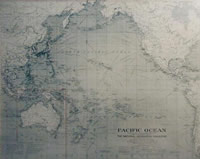
The initial directives to MacArthur in his new role were to hold 'the key military region of Australia as bases for future offensive action', to check the Japanese advance in his region and to maintain the American position in the Philippines.22 Historians all agree that the directives and the Australian acceptance thereof represented for Australia a 'notable surrender of sovereignty'.23 While Australia would at least initially provide most of the armed forces in the region, and battles in the immediate future would for the most part be in her territory, these troops would be commanded by an American general directed by the US Chiefs of Staff. And this arrangement was to require a close working relationship between a clearly Republican party general and a centre-left Australian politician. MacArthur, for his part, was said to be suspicious of US government policy. However, despite alternative suggestions to the contrary, MacArthur appointed Americans to lead every branch of his staff: indeed, eight of the eleven heads were officers who had come with him from the Philippines.24
Australian General Thomas Blamey was appointed to lead the Allied Land Forces but the Navy and Air Force forces in MacArthur's command area were also under US leadership. Nevertheless, Curtin wrote to MacArthur promising 'every possible support... in naming Australia secure as a base for operations' and from there to 'wrest the initiative from the enemy' and undertake the 'ultimate offensive'.25 However, by 18 April when MacArthur formally assumed his command which embraced all combat units of the Australian defence forces, Curtin had at least succeeded in securing the right of Australian commanders to have access to their own government26 and in amending the terms of the command so that the Australian Government had the ultimate control over the disposition of Australian troops outside of Australian territory.27
JCPML. Records of Douglas MacArthur. General Sir Thomas Blamey, General MacArthur and PM Curtin, Melbourne, 194? JCPML00265/6.
Original held by MacArthur Memorial Library and Archives: MML&A 9566.
At the time of MacArthur's arrival in Australia there were about 25,000 US troops in the country, most of whom had originally been destined to participate in the fighting in the Philippines. For a time at least the paucity of available forces was such that MacArthur was said to have 'lost heart and wanted to give up' and this despite his initial optimistic predictions at the Advisory War Council meeting. Planning nevertheless proceeded apace and by April there were 33,000 American troops, 46000 AIF troops who had returned from the Middle East plus 63000 other AIF men and 280,000 militiamen.28
The defence structure which now emerged, essentially at MacArthur's suggestion, included a new body, the Prime Minister's War Conference, consisting of Curtin, MacArthur (but not Blamey), ministers deemed appropriate for the matters being discussed and Defence Secretary Frederick Shedden as a member as well as secretary, the function he performed in the war cabinet. Effectively this made MacArthur and not an Australian 'Curtin's chief adviser on military matters'.29 In turn, Curtin's prime concern from the outset was to secure an American commitment to an offensive against the Japanese which would entail the US Government giving a high degree of priority to the Pacific war.
A US machine gunner of a Flying Fortress loading a magazine at a base somewhere in Australia, 1942.
Courtesy National Archives of Australia: A11663, PA189
it became apparent that the European war was to be given absolute priority
The Prime Minister's War Conference met three times in April 1942 and late that month MacArthur issued his first directive 'related to a general plan' indicating that the Allied Land Forces had as their initial objective to prevent 'any landing on the north-east coast of Australia or the south-western coast of New Guinea', though at that stage no additional forces were 'sent forward to help carry out these tasks'.30 The initial assumption was that MacArthur's submissions for the troops and equipment he needed to carry out his directives would carry considerable weight in Washington and London. Over the next few weeks, however, MacArthur, Curtin and External Affairs Minister Evatt were all frustrated as it became apparent that the European war was to be given absolute priority and as a consequence there would be no additional reinforcements for the Australian area even as the Japanese threat mounted. In turn, MacArthur at the War Conference meetings now urged Curtin to seek the return of the 9th Division from the Middle East.
Although the Battle of the Coral Sea and the thwarting of an immediate attack on Port Moresby in early May did little more than provide breathing space, the American success at Midway Island led MacArthur, when meeting with Curtin in Melbourne on 11 June to state, somewhat prematurely as it transpired, that 'the security of Australia had now been assured'.31 Paradoxically the apparent easing of the invasion crisis posed problems and Curtin was obliged to do all he could in his public utterances to maintain the commitment of the populace to the war effort by asserting that what had so far occurred was 'by no means decisive'.32
Prime Minister John Curtin (right) with Frederick Shedden entering GHQ Brisbane for his conference with General MacArthur, 27 June 1944.
Courtesy National Archives of Australia: A5954, 661/12
the very day after MacArthur reached Brisbane, the Japanese landed troops on the north coast of New Guinea
MacArthur moves to Brisbane and the battle for New Guinea, July 1942 to January 1943
Link to map showing places mentioned in the essay. - need to find a suitable map.
On 20 July, seemingly convinced that the invasion threat had dissipated and the war was moving towards an offensive stage, MacArthur shifted his headquarters from the Menzies Hotel in Melbourne to Brisbane. He and most of his staff took up quarters in Lennon's Hotel while working from the eighth floor of the city's largest office building, the AMP building, on the corner of Queen and Edward Streets: most days MacArthur would visit his family at the hotel for lunch.33 Earlier in the month MacArthur had proposed to the Chiefs of Staff that there be an immediate offensive to recapture Rabaul, the islands of New Britain and New Ireland, and then proceed northwards but the Chiefs of Staff gave priority to areas further east including the Solomons.
In any case, on the very day after MacArthur reached Brisbane, the Japanese landed troops at Buna and Gona on the north coast of New Guinea thereby thwarting MacArthur's plans to establish his own bases there for an assault on Rabaul. Even at this stage MacArthur and the Australian military leaders still seem to have failed to appreciate that the Japanese were planning to attack Port Moresby across the Owen Stanley Range via the Kokoda Track.34 This view quickly changed as the Japanese advanced against light resistance and on 29 July captured the important airfield at Kokoda. In mid August, as the situation deteriorated in the Solomons, Curtin met with MacArthur in Brisbane. At this time Curtin was attempting to blunt or silence Opposition criticisms, warning his opponents that they could be divulging information to the enemy and be embarrassing to MacArthur. He subsequently repeated these assertions warnings to a secret session of parliament on 3 September.35
Queen St, Brisbane, looking south. The AMP Building is the tallest building (9 storeys) on the left side.
Courtesy National Library of Australia: Frank Hurley collection, pic FH/486
During August the Japanese continued their advance southwards through New Guinea
During August as the Japanese continued their advance southwards through New Guinea and also made a landing at Milne Bay, reinforcements were sent from Australia to Port Moresby. However, by mid September, after heavy fighting the Japanese had reached within 25 miles of the Port, while requests for further reinforcements were consistently rebuffed by Roosevelt and Churchill. On 17 September MacArthur urged Curtin to send General Blamey to Port Moresby to relieve the then Commander Lieutenant General Sidney Rowell. The latter was subsequently sent back to Australia and a heated controversy arose between the two Australian generals.36 David Horner has also suggested that having Blamey in New Guinea was a means for MacArthur, even at this stage, of effectively removing Blamey from overall control of the Allied Land forces, thus leaving Blamey responsible only for Australian troops and open to taking responsibility for any possible failure.37 On this issue, Horner insists, Curtin effectively gave way to MacArthur.38 For MacArthur, this was a crisis period and when he phoned Curtin on 16 September MacArthur admitted 'he was seriously worried'. Indeed, in hindsight, one must assume that if Port Moresby had fallen, MacArthur's career would have been over.39
Worrying as the situation appeared at the time, the Japanese front line in mid September proved to be as far south as their supply lines could support while by this time there were nine Allied brigades in New Guinea compared with three in late July.40 In August the Japanese landing at Milne Bay had been repulsed in what is generally regarded as the first significant military land defeat for Japan in the war and on 18 September the Japanese commenced a retreat back to the north coast. Throughout this invasion threat period all Curtin's and MacArthur's appeals for help from the US and Britain had been rebuffed. Even so, in retrospect it can probably be conceded that the Allied High Command were correct in their assessment that a Japanese invasion of Australia could be prevented without sending substantial additional troops from the European frontier.41
MacArthur's headquarters - The AMP building and interior of MacArthur's office in 2006.
Coutesy MacArthur Museum Brisbane.
Throughout this invasion threat period all Curtin's and MacArthur's appeals for help from the US and Britain had been rebuffed.
On 2 October MacArthur himself visited New Guinea for the first time and the Allied push northwards back along the Kokoda Track got under way though with delays caused by supply difficulties. American troops were also brought in for other lines of advance. By November the threat in the Solomons had been largely overcome and MacArthur had moved his advance base to Port Moresby, shuttling backwards and forwards between Brisbane and New Guinea.42 Even so it took weeks of heavy fighting and significant losses before the Allies were relatively firmly established in Buna and surrounding bases on the New Guinea north coast. Dating from October 1942, Japanese air attacks on Northern Territory airfields had been diminishing in frequency and scale and on 11 January 1943 Curtin felt able to congratulate MacArthur officially on his victory in New Guinea.43
Despite these successes, the Allies, for a variety of reasons, were not yet in a position to launch an attack on Rabaul and instead a 'holding war' continued for the time being. Curtin, did have one immediate success when, despite strong resistance from Churchill and Roosevelt, the Australian 9th Division was able to return from the Middle East in February 1943. However, on the other side of the ledger, Curtin did not even know the time and place of the Casablanca Conference in January 1943 until after it had taken place and he was subsequently critical of the effects of its decisions to give the Pacific War a continuing low priority.44
Members of the 2/3rd Australian Independent Company, New Guinea, July 1943.
Courtesy National Library of Australia: Arden family collection.
MacArthur had been urging Curtin to merge the all volunteer AIF and the conscripted militia into one force
Curtin and military conscription 1942-1943
From August 1942 onwards45 MacArthur had been urging Curtin to merge the all volunteer AIF and the conscripted militia into one force which could be deployed outside of Australian territory.46 At this stage only 530,000 of the 820,000 strong Australian army forces could be required to serve outside Australian territory. Accordingly, Curtin was persuaded to attempt to modify the law both because the existing situation left the impression of conscripted Americans carrying the main burden of defending Australia and because a continuance of the status quo would limit the role that Australian troops could play in any subsequent advance against the Japanese. Even so, Curtin's stance as a strong anti conscriptionist during World War One meant that it came as a 'bombshell' to his party colleagues when, at the federal Conference of the ALP Melbourne on 16 November 1942, he proposed extending for military purposes the definition of 'Australian territory' to embrace areas declared by the Governor-General as 'territories associated with the defence of Australia'. Led by Arthur Calwell, Curtin's opponents managed to have the issue scheduled for resolution at a special federal conference in January 1943. However, despite constant criticism Curtin held firm and won the day, though the issue in personal terms 'had cost him dearly'.47 As it was, when the enabling legislation came before Parliament his compromises with party colleagues meant a much more limited definition for what constituted Australian territory.48 This in turn led Menzies to describe the measures as not worth 'the toot of a tin whistle' and the Brisbane Telegraph to deplore what it called 'fantastically stupid proposals'.49 In any case the amendment served 'no great practical purpose' since throughout the remainder of the war all fighting outside Australian territory by Australian soldiers was left in the hands of volunteers, except for one force in Dutch New Guinea.50
Map of the SW Pacific region, showing the extended boundary within
which Australian conscripts could serve following the passing of
the Militia Act in Feb 1943
Courtesy National Archives of Australia: A5954, 1937/14
